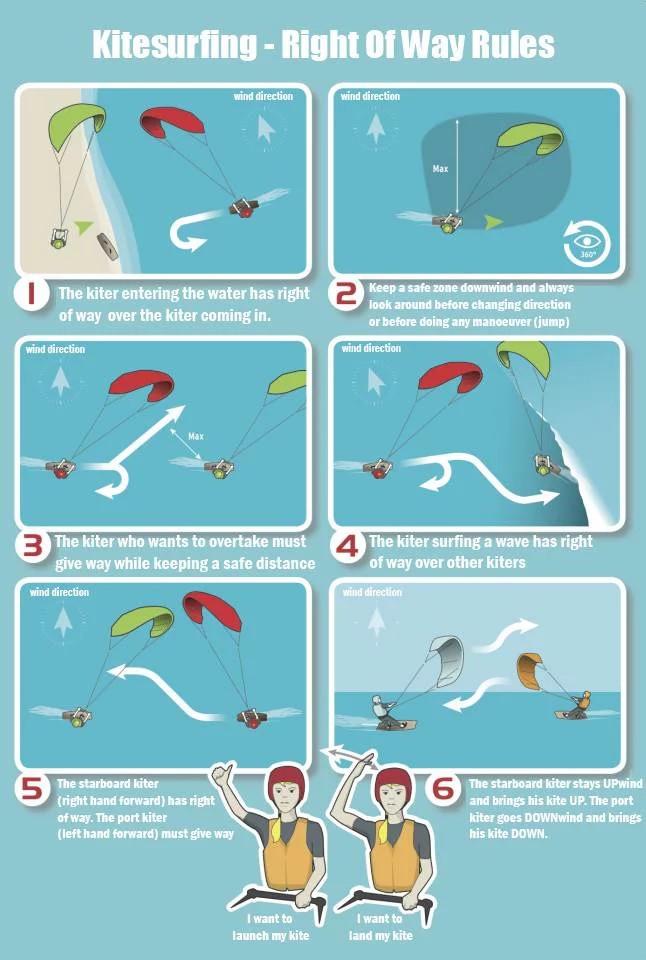
The Kiteboarding Rules of the Road (The Right of Way)
Share
In this article we are going to go over the kiteboarding rules of the road a.k.a, the right of way.
Don't be the person that ruins it for everyone else because you neglected these simple rules....
In crowded conditions the possibility to collide with other kiters exists. It is important to know how to react and behave in order to avoid accidents. The following are the most common right of way rules for kiteboarders

Avoid collisions at all costs.
Follow the rules but not to the point of having a collision, even if you have right of way, you must act prudently to avoid an accident. Some sailors don't know the rules. This is part of the "prudential rule".
The Prudential Rule
There is no rule that excuses you, for not knowing the weather, having the correct gear, keeping a proper lookout, and avoiding accidents (Acting Prudently).
The incoming Kiter gives way to the outgoing kiter who is launching.
Situation: one kite is launching and ready to leave the beach, and another kiter wants to come in and land at the same time.
Definition: The launching kiter is standing with their lines tensioned obviously ready to launch.
What to do: The incoming kiter should turn around and go back out for another tack, while the launching kiter gets off the beach.
The upwind kiteboarder gives way to the downwind kiteboarder.
Situation: when two kiters are on the same tack but their paths will cross. Usually the upwind kiter is not pointing as high as the downwind kiter.
Definitions: the upwind kiter is sailing closer to the wind than the downwind kiter.
What to do: The downwind kiter has right of way, so they should continue to ride in the same direction and speed, the upwind kiter must give way, by altering direction or speed, usually slowing and going behind the other kiter.
The kiteboarder on port tack gives way to the kiteboarder on starboard tack.
Situation: When you meet another Kiter head on, and you are both on opposite tacks, the port tack rider gives way to the Starboard tack rider.
Definitions: When you have your kite on the right hand side of the wind window, between 12 and 3oclock. you are riding on "Starboard tack" and have right of way. When you are riding with the kite between 9 o'clock and 12 o'clock. you are said to be on "Port Tack" you must give way.
How to give way: To give way to the Starboard tack rider, you should slow down or alter course (usually downwind keeping your kite low). The kiter of Starboard tack should maintain his direction and speed.
When crossing close to another kiter, the upwind kiter keeps his kite high,
and the downwind kiter keeps his kite low.
Situation: You are riding on the opposite tack from another rider, you are close but but you will miss each other.
Definition: If it is obvious that you do not have to alter course or speed to miss the other rider, you should position your kite to keep it away from the other kite.
What to do: The kiter passing upwind raises their kite, and the downwind kite lowers their kite. Do not move your kite to the point where you will change speed or alter course significantly.
Do not jump when you are upwind of another kiter.
Situation: When you are preparing to jump, close to other kiters.
Definition: If any part of your jump will take you over near to, or into the path of another kiter or their gear.
What to do: Keep a clear area ahead behind, and downwind of you before you jump. Keep in mind your jump may not go as planned, you go wipeout, or go higher and further than you planned. Also the other kiter could change course or act unexpectedly.
Look in all directions (including up) before you jump.
Keep a proper lookout at all times. Do not ride close to other riders, they could turn unexpectedly. Look in all directions ahead, behind, upwind, downwind, and straight up! There could be another kiter or someone's kite above you!
Next Step:
Just incase you forgot, here is the self-rescue again.
